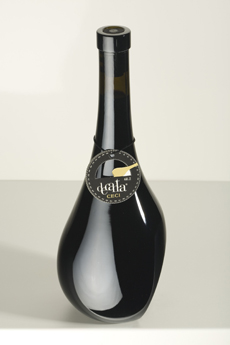WINE: The New Wine Bottle-Decanter

Turn this bottle-decanter combo on its |
Congratulazioni to the designers at Cantine Ceci in Torrile, Italy (outside Parma). Their patented wine bottle innovation, “Decanta 68.2” has won an award at the International Packaging Competition at Vinitaly 2010. It will be presented to consumers during the large Italian wine fair, which runs from April 8th to the 12th in Verona.
This “evolution of the species” is the first combination wine bottle-decanter: useful to decant wine with sophistication in design. Decanta 68.2 can serve as a gift, a table decanter and a tabletop objet d’arte. When set on its side, the degree of tilt enables perfect oxygenation. The label side is placed down on the table, so the line of the design is not interrupted. The cork is made from silicone so you it can be easily recorked (and reused with other wine!). In addition to Decanta 68.2, Cantine Ceci is introducing Rock Otello Dry², the first sparkling wine in a square bottle. Now the practical question: Can smaller retailers easily fit these larger-footprint bottles on the shelves? |
|
| The wine that inhabits these bottles is Lambrusco, one of the most ancient wines, with archaeological evidence dating back to the Etruscans. Today this red wine is made in the Emilia-Romagna and Lombardy regions of Italy (Mantua, Modena, Parma and Reggio nell’Emilia).
The gauntlet has been thrown.* It’s no longer good enough to create a wine with a nifty name and label design. The challenge now is to out-bottle-design your competitors. Winemakers of the world, take heed! *If you don’t know what a gauntlet is: It’s a knight’s glove, made of mail or plate, worn to protect the hand in combat (hopefully, it matched one’s armor!). When one knight wanted to challenge another, he threw down his gauntlet, which landed at the feet of the prospective combatant. If the second knight accepted the challenge (and he was generally honor-bound to do so), he picked up the gauntlet. Now for the big question for Medieval historians: Did the challenger get his gauntlet back when his challenge was accepted, or did the challenged knight get to keep it?
|
||